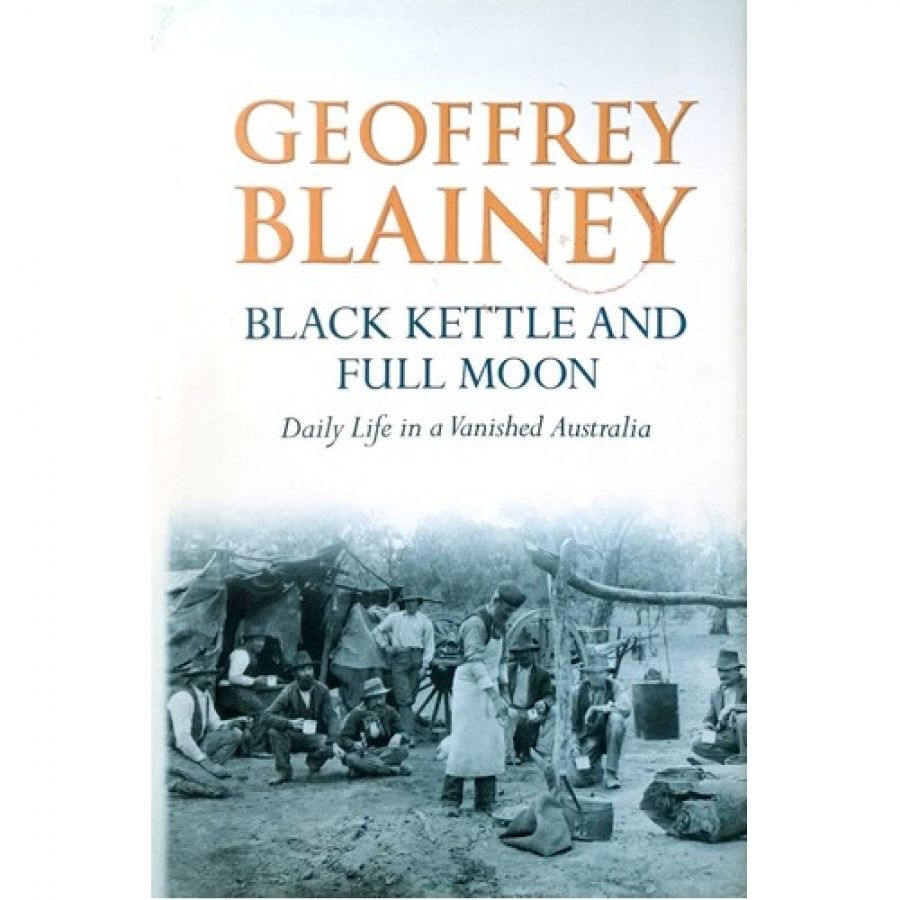
- Free Article: No
- Contents Category: Australian History
- Review Article: Yes
- Article Title: A Handful of Details
- Online Only: No
- Custom Highlight Text:
Geoffrey Blainey is seventy-three years old and has published thirty-two books. Since his last book was a history of the world, one might have assumed that he had reached the end of his career. But he is not done yet. He moves, as he has always done, from grand speculation to what might be thought trifles – in this case, the details of everyday life in Australia from the 1850s to 1914.
- Book 1 Title: Black Kettle and Full Moon
- Book 1 Subtitle: Daily life in a vanished Australia
- Book 1 Biblio: Viking, $45 hb, 493 pp
- Book 1 Cover Small (400 x 600):

- Book 1 Cover (800 x 1200):

Matters that have been regularly treated also appear, but for new purposes. Ned Kelly, we are told, must have been a consulter of almanacs, because he planned his robberies at times when the moon was full to assist his escapes. Before the Burke and Wills expedition left Melbourne, Burke spoke to the large crowd that had assembled in Royal Park, estimated at between 10,000 and 15,000 people. The Herald reported that Burke could be heard all over the crowd, which introduces a discussion of how speakers reached their audiences before microphones. The Heidelberg School of painting makes its appearance to demonstrate the use of sun umbrellas by women and the prevalence of cigar smoking among men, for the paintings of the celebrated ‘9 x 5’ exhibition in 1889 were done on the lids of cigar boxes. ‘The Drover’s Wife’, by Henry Lawson, illustrates modes of illumination, with Blainey giving Lawson the rare honour of a direct quotation:
The thunder-storm comes on, and the wind, rushing through the cracks in the slab wall, threatens to blow out her candle. She places it in a sheltered part of the dresser and fixes up a newspaper to protect it. At every flash of lightning, the cracks between the slabs gleam like polished silver.
I guess that never before has this passage been the only one singled out for attention. I have read the story scores of times, but could not have said how the drover’s wife protected her candle. When the candle fails, she runs outside to get wood to build up the fire. Blainey then briefly turns literary critic: ‘The inadequate light adds tension to the scene.’
Blainey’s alertness to smells, sounds and sights has always been a characteristic of his books. In this one, they have become central themes: the whiff of sewage in back lanes; the cooee borrowed from the Aborigines; the difference between the light of gas and electricity (Melba preferred gas). He also notices the forms of human movement: ‘Most people dipped their pen with the kind of slow deliberation also used in the lighting of a pipe.’
As usual, there are no footnotes to support the mass of particularities that make up the book. There is a list of selected sources, preceded by a very revealing account of how the book came into existence. When Blainey reached national prominence, now more than thirty years ago, people setting up folk museums sometimes ‘phoned or wrote for elementary information about candlesticks, tobacco tins, needles and soft drink bottles’. Because he often could not provide the information, he became more alert for such details when he was researching other matters. But the people themselves have provided some of the information. Blainey would chance to meet, say, an old butcher who could tell him about sausage-making in the 1920s. At the numerous gatherings where he was asked to speak, he would talk on ordinary life and then, during question time, ‘members of the audience would sometimes put me right or supply fascinating details from their own experience’. The book is a testament to the bond Blainey has with the people whose lives he has celebrated.
The trifles of everyday life are strung together in a cheerful frolic with little attempt to draw deeper meanings, though this does not mean that Blainey fails to hold the reader’s attention. Sometimes there are gentle rebukes of modish thought. We should not chide our ancestors over their stodgy food, because their hard labour made them fit and lean. Women’s ‘liberation’ existed before 1914 in the power women exercised over men in the matters of alcohol and tobacco. In the final chapter, there is an attempt to defend old Australia from the charge of being ‘stolid, unimaginative, unchanging and lacking in diversity’. Blainey has no difficulty in showing that there were major changes between the 1850s and 1914 in way of life and standard of living. The other charges are left unanswered.
I have failed in the reviewer’s office of finding mistakes. However, I have discovered a typical Blainey omission. In 1913 the Commonwealth government issued a postage stamp showing a kangaroo rather than the king’s head. There was an outcry and, later in the year, George V was restored, though wreathed in wattle. Blainey does not tell us that a Labor government issued the first stamp and a Liberal the second. Politics, in his books at least, has not been important.
There is one slack passage. Blainey reports that newspapers were carried free through the post in New South Wales and Tasmania, ‘and perhaps other colonies’. Why didn’t he get his research assistant to check the practice in other colonies? Perhaps he does not have one. All his books seem to have been written without the assistance that grantmanship now encourages us to think essential. He carries many things in his head. A lot of old Australia will die with him – except of course what will survive in his books.


Comments powered by CComment